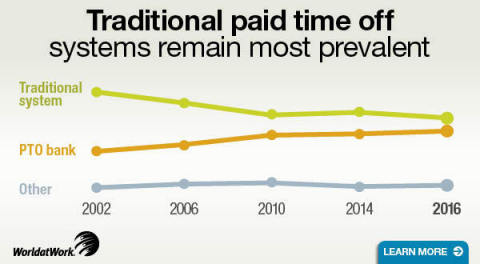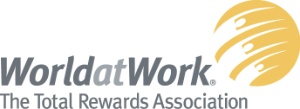WASHINGTON--(BUSINESS WIRE)--According to a new survey, “Paid Time Off Programs and Practices” by WorldatWork, 88% of organizations believe it is necessary to offer some type of paid time off program to attract top talent and drive organizational success. (See Figure 54.) WorldatWork, a nonprofit human resources association and leading compensation authority, conducted the January 2016 survey of its membership to measure specific types of paid time off programs and their effect on today’s workforce.
Employee paid time off programs remain an important benefit in the total rewards tool kit, with companies reporting the following top three reasons for offering paid time off programs to employees: encouraging employees to rest and rejuvenate, improving employee attraction and satisfying employee paid time off expectations. (See Figure 55.)
WorldatWork’s 2016 survey examines traditional leave systems that offer separate buckets of vacation time, sick time and personal days off, and a paid time off (PTO) bank-type system that aggregates an allotted amount of available days to be used for a variety of types of absences. In 2016, 79% of Health Care & Social Assistance companies are using a PTO bank. (See Figure 5b.) Additionally, more than 50% of private sector, publicly traded companies (58%) and nonprofit/government organizations (56%) prefer traditional leave systems. (See Figure 5c.)
“Now more than ever, organizations are being forced to restructure their paid time off programs,” said Lenny Sanicola, WorldatWork senior practice leader. “Today, we’re seeing new paid time off laws, including parental and family leave benefits, at the local and state levels combined with more companies expanding their paid time off policies to attract employees and boost morale. Organizations understand they can no longer be competitive if they don’t get creative with their own paid time off benefits. For many employees, paid time off is more important than other traditional pay and benefits.”
According to the survey, 96% of participating organizations are “covered employers” under the U.S. Family and Medical Leave Act of 1993 (FMLA), meaning that they are subject to the requirements of the FMLA and must allow employees with qualifying reasons to take a specific duration of job-protected leave. (See Figure 39.) A majority of companies (82%) offer job-protected leave that is mandated by the FMLA and any state/local laws. The remaining 18% of mandated organizations are more employee friendly with job security provisions for new parents, meaning that they offer job protected leave and more flexibility.
This data is independent of whether these organizations offer income replacement options during job-protected leave for new-parent employees. (See Figure 41.)
A few additional highlights from the 2016 survey:
- Organizations with a traditional leave system are more likely to report higher percentages of low (0% to 5%) voluntary turnover (65%) than their PTO bank counterparts (35%). (See Figure 5d.)
- When organizations offer paid parental leave, 54% offer fewer than six weeks of paid leave, 16% offer six weeks and 16% offer 12 weeks. (See Figure 49.) 44% require a tenure of 12 months or more before the employee can use paid parental leave. (See Figure 50.)
- Of the 18% of organizations that are more employee friendly with their job protected leave provisions, the most common new-parent employees offered job-protected leave include: birth mothers (98%), biological fathers (96%) and adoptive parents (also 96%). (See Figure 43.)
- At least seven in 10 organizations in either type of paid time off system offer paid time off to part-time employees. (See Figure 52.)
WorldatWork conducted similar paid time office program surveys in 2014, 2010, 2006 and 2002.
*Figure numbers referenced are from the 2016 WorldatWork survey, “Paid Time Off Programs and Practices.”
WorldatWork experts are available for interviews to discuss this survey. To schedule an interview, please contact Melissa Sharp Murdock at melissa.murdock@worldatwork.org or 202-315-5565.
About WorldatWork®
The Total Rewards Association
WorldatWork (www.worldatwork.org) is a nonprofit human resources association for professionals and organizations focused on compensation, benefits, work-life effectiveness and total rewards — strategies to attract, motivate and retain an engaged and productive workforce. WorldatWork and its affiliates provide comprehensive education, certification, research, advocacy and community, enhancing careers of professionals and, ultimately, achieving better results for the organizations they serve. WorldatWork has more than 70,000 members and subscribers worldwide; 80 percent of Fortune 500 companies employ a WorldatWork member. Founded in 1955, WorldatWork is affiliated with more than 70 local human resources associations and has offices in Scottsdale, Ariz., and Washington, D.C.




